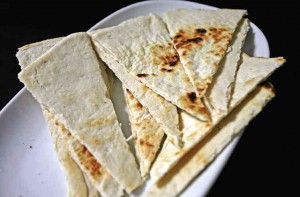Italian cooking is never more interesting, fun and easy to learn than when taught by an expert whose name is almost synonymous with Italian cuisine in the country—chef Margarita “Gaita” Forés.
Two weeks ago, Forés gave a hands-on lesson on the art of Italian home cooking at Casa Artusi Philippines, Whitespace, in Pasong Tamo Extension, Makati City.
Side by side with good friend and Italian master chef Carla Brigliadori, Forés demonstrated the making of classic homemade pasta, a selection of antipasti, three kinds of pasta sauces and various pasta shapes, such as farfalle, garganelli, pappardelle, cappelletti, ravioli and tagliatter, to name some.
Brigliadori instructed in her native language while Forés adeptly translated into English as they went about preparing Polpette di Trippa, or a tripe meatball recipe, for starters. They bantered about and dished out valuable tips while efficiently rolling pasta dough.
“There should be a hand-and-knee coordination when rolling the dough,” said Forés. “The rocking movement, front and back, comes from the knees and shoulders, and the arms must be relaxed. Use the hands to turn around the dough, not the rolling pin.”
Brigliadori said she feels right at home whenever she’s in Manila, and she enjoys the many ingredients available in the market which are quite similar to what one can have in Italy, such as duck egg and tomatoes.
Brigliadori used duck eggs to make the pasta. Chicken eggs, she observed, are a bit runny.
“Authentic Italian cooking offers simple procedures but are packed with goodness,” she said. “And the goodness always comes from the freshest available ingredients.”
Brigliadori and Forés also shared the basic preparation for piadina or the famed Italian flatbread using only pork lard, flour, baking soda, salt and water. In Italy, piadina is a family dish often prepared by women whenever their husbands would come home from the farm.
“Some add wine or honey to the dough mixture,” said Forés. “It’s like each Filipino family has its own version of adobo. They add a step or two or a secret ingredient to create their own unique recipe.”
Piadina is ideally served with a sweet mix of honey, goat cheese and mango jam, or a savory blend of salami, prosciutto and ricotta cheese.
Casa Artusi Philippines’ next cooking class will be held in January. For the schedule of classes, visit www.casaartusiphilippines.com.

Piadina
500 grams flour
140 g pork fat
10 g salt
2-3 g baking soda
150-200 milliliter water, room temperature
Polpette di Trippa
350 grams boiled tripe, chopped finely
100 g partly trimmed prosciutto, chopped finely
30 g grated Parmesan cheese
20 g beef marrow, chopped finely
2 eggs
A generous pinch of parsley, chopped finely
A dash of spices or nutmeg
2 tablespoons mash made with bread soaked in broth or milk
Mound the flour in the center of a large wooden cutting board. Make a well in the middle of the flour. Place pork fat, salt, baking soda and a little water at a time.
- Blend in the flour by incorporating the inner rim of the well. Retain the well shape as you do so. Continue until the dough comes together.
- Knead for 5 minutes. Let rest for 10 minutes, covered.
- Divide dough into 100-gram portions. Form into flat rounds.
- Place dough on a flat terra cotta or iron pan.
- Cook both sides of piadina for 2-3 minutes.
Polpette di Trippa
- Blend tripe, prosciutto, marrow, parsley, eggs and the rest of the ingredients. Make 12 or 13 balls.
- Roll in flour.
- Fry in oil or lard.
E-mail the author at vbaga@inquirer.com.ph.